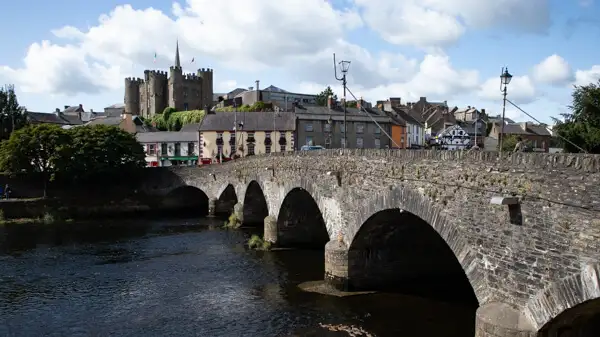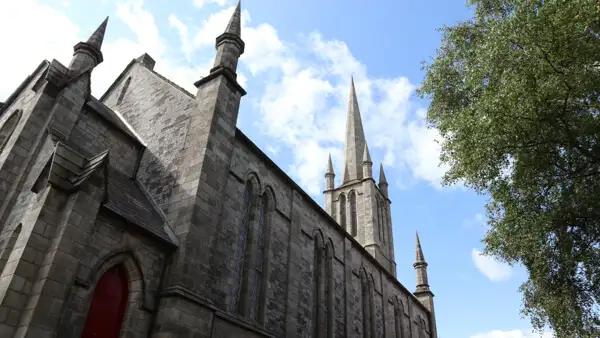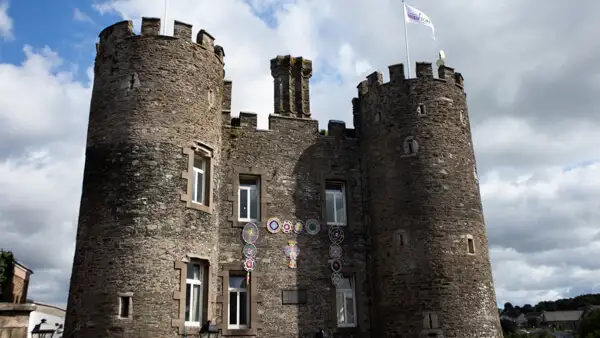The River Barrow babbles cozily beneath the old bridge, while on the other bank the pretty little castle rests comfortably above the scenery. But the tranquillity is deceptive….
Page Contents (click line to jump the text)

Intro: The rebellion of 1798
The small town of Enniscorthy really has it all. Around 220 years ago, it was the centre of resistance by Irish rebels against English rule. It was here that the discontent of the Irish population simmered against the oppression of the English occupiers in the Kingdom of Ireland, who were by no means squeamish.
It was the time when the great revolutions shook the foundations of the traditional feudal order in Europe and North America. The French Revolution had been underway for several years from 1789 and France was not far from Ireland.
The idea of removing the aristocratic elites in a coup d’état and replacing them with a new order hovered like a sword of Damocles over the whole of Europe and also reached the islands in the Atlantic. In any case, from an Irish perspective, France was never far away.
Years earlier, from 1775, the Americans had already rebelled against British rule and adopted the United States Declaration of Independence on 4 July 1776.
This was the first time that human rights had been formulated, such as the right to freedom, life and happiness. In 1783, the British were forced to concede defeat in America in the “Peace of Paris”.
The year is 1798 in Enniscorthy. Ireland has been seething for a long time. The British occupation weighed too heavily on the Irish population. The Penal Laws exclude the Catholic Irish from access to many areas of life.

Political office, power and wealth, or simply modest prosperity, are reserved for Protestant Britons. The Catholic Irish were also not allowed to own weapons.
But the wars of independence in America take their toll on the British. They are forced to withdraw troops from Ireland and send them to America.
In their place, they set up a vigilante organisation, the Irish Volunteers, recruiting and arming not only British citizens in Ireland but also supposedly loyal Irish citizens due to a lack of manpower.
The Irish Volunteers represented a major power factor that increasingly opposed the British masters in the years that followed. Following the ideas of the French Revolution, an increasingly political group, the United Irishmen, emerged from this group. They asked the French government for help, but the French army that had marched was forced to turn back en route due to adverse weather conditions and never reached the island. This was the failed revolution of 1796.
Two years later, the Irish try again, this time on their own. The British were able to defend Dublin and put down several skirmishes throughout the country in a very short time. Only here, in County Wexford, can the rebellion hold out.

On 21 June, the decisive battle takes place on Vinegar Hill opposite Enniscorthy Castle. There are differing accounts of the size of the two armies, but there were probably over 10,000 well-equipped British soldiers facing a presumably even larger number of poorly equipped and badly trained rebels. In addition, the British had and utilised their artillery, while the rebels did not even have enough muskets. The British won the battle that day and the 1798 rebellion was crushed.
Nevertheless, the rebellion marked the beginning of a new era. The British had realised that they could not remain successful with their tyranny in the long term. The experiences in America were also too profound. They therefore granted the Irish more extensive freedoms and rights and with the Act of Union, the Irish Kingdom was united with the British to form the United Kingdom of Great Britain and Ireland. However, the Irish still had to wait over 100 years for Irish independence.
The National 1798 Rebellion Centre
The National 1798 Rebellion Centre near Enniscorthy provides information about this period and goes to great lengths to do so in a clear, interactive and entertaining way. See: http://1798centre.ie/.
Vinagar Hill
Vinegar Hill is the site of the 1798 battle and is located opposite the hill on which Enniscorthy Castle and the old town lie. Elaborate re-enactments of the battle take place here every year. But you can also just take a walk over the green hill. See: http://vinegarhill.ie/.

Enniscorthy Castle
A beautiful old bridge takes you over the River Barrow to the castle and into the old town. The pretty little early Norman castle from the 13th century lies almost inconspicuously on the hillside, but is very well preserved and restored. In its time it has seen Anglo-Normans, Englishmen, Irish rebels and also served as a prison. Inside, from the dungeon to the roof, you will find several exhibitions that you can view at your leisure. From the upper floors you also have beautiful views over Vinagar Hill and the surrounding area. See: http://enniscorthycastle.ie/plan-my-visit/about-enniscorthy-castle.
The old town of Enniscorthy
Above the castle lies the pretty old town of Enniscorthy with many beautiful old buildings, a pedestrianised area and numerous small shops. Just wander around a bit and take the time for a nice lunch or a cosy teatime.
Conclusion
I have been to Enniscorthy several times myself and know the small town well. In addition to tourist visits, I also have business contacts here. We come from Germany originally.
Enniscorthy is a nice little town and it’s worth stopping off here to visit the castle, the old town and the Rebellion Centre. You can easily combine this with your journey to or from Wexford, Waterford or Kilkenny.
Have fun in Enniscorthy!
Other interesting articles for you
THE IMPRESSIVE KILKENNY CASTLE
THE MEDIEVAL TOWN OF KILKENNY
WEXFORD – SO OLD – SO NEW!
HOOK HEAD LIGHTHOUSE – THE OLDEST ACTIVE LIGHTHOUSE IN THE WORLD
More article links will follow shortly….
Picture credits cover picture: Beautiful Slaney Street in Enniscorthy, photo by Ulrich Knüppel-Gertberg (www.irland-insider.de, www.ireland-insider.com)